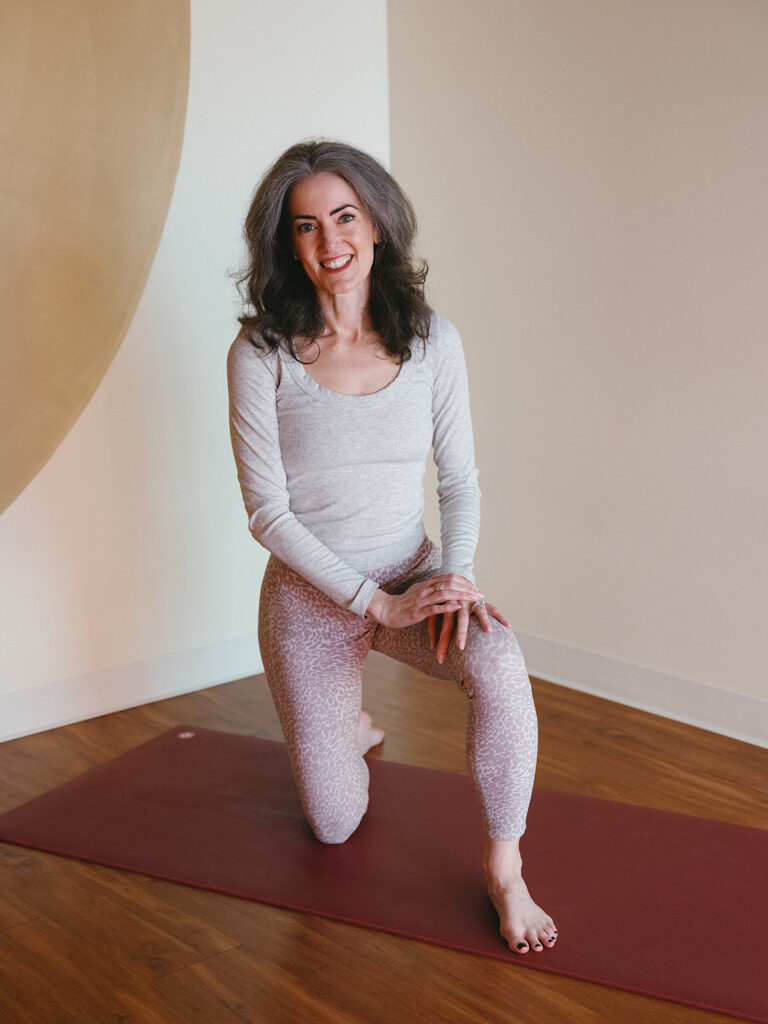The most transformative element of your yoga class isn’t your sequence—it’s the invisible conversation between your nervous system and your students’.
Have you ever walked into a yoga class feeling frazzled and left feeling grounded, even though the teacher barely mentioned stress relief? Or perhaps you’ve experienced the opposite: entering a “relaxing” class but leaving somehow more anxious than before.
What’s happening in these moments goes far beyond the poses or even the words spoken. It’s a phenomenon called nervous system co-regulation, and understanding it could transform your teaching more profoundly than any advanced training in sequencing or alignment.
What Is Nervous System Co-Regulation?
The concept of co-regulation is backed by neuroscience. Our nervous systems don’t operate in isolation—they’re constantly in communication with other nervous systems around us.
When you walk into a room with a calm, regulated person, your own system begins to synchronize with theirs. Likewise, when you’re around someone anxious or agitated, you might find your own heart rate and breathing quickening in response. This isn’t imagination or suggestion—it’s biology.
Research from UC Berkeley has shown that yoga directly influences our nervous systems, with practices like deep breathing activating the vagus nerve, which helps regulate many bodily functions including heart rate and digestion. What’s fascinating is that this regulation doesn’t just happen within an individual—it happens between people too.
Why Co-Regulation Matters for Yoga Teachers
As yoga teachers, we are not just instructors of physical movement—we are regulators of the room. Our nervous system state sets the tone for everyone present, regardless of how meticulously we’ve planned our sequence or how precise our alignment cues are.
Consider these scenarios:
- You rush into class after fighting traffic, feeling stressed and scattered. Even though you teach your planned “relaxation sequence,” students leave feeling mysteriously unsettled.
- You take five minutes before class to ground yourself, regulate your breathing, and set an intention for presence. You teach a challenging sequence, but students leave feeling both energized and calm.
The difference isn’t in the poses—it’s in your nervous system state and how it influenced theirs.
Practical Ways to Harness Co-Regulation in Your Teaching
1. Regulate Yourself First
Take 3 to 5 minutes before class to ground yourself. This isn’t indulgent—it’s essential preparation for effective teaching. Simple practices might include:
- Seated breathing with one hand on your belly
- A brief body scan to release tension
- Setting an intention for presence, not perfection
Remember: your regulated nervous system becomes an anchor for everyone in the room.
2. Speak from Your Center
The quality of your voice directly impacts students’ nervous systems. Speaking from your diaphragm rather than your throat creates a deeper, steadier sound that signals safety.
Practice by placing a hand on your belly as you teach, feeling the engagement of your diaphragm. Notice how this naturally slows your speech and brings more intention to your words.
3. Create Purposeful Pauses
Many newer teachers fear silence, filling every moment with instruction or motivation. But nervous systems need space for integration.
Try consciously pausing:
- After giving a key instruction
- During transitions between poses
- Before and after demonstrations
These pauses aren’t empty—they’re rich opportunities for students to process and embody the practice.
4. Navigate Transitions Mindfully
Transitions between poses are where nervous systems often get dysregulated. Students may feel vulnerable or uncertain during these moments.
Slow down, simplify your language, and use fewer words during transitions. Consider your pacing—giving students ample time to find their way from one shape to another signals that there’s no rush, no need for the sympathetic nervous system to activate.
5. Match Your Energy to Your Intention
Different class styles call for different energetic qualities. A vigorous flow might welcome enthusiastic encouragement, while a restorative class needs a softer approach.
Before teaching, ask yourself: “What nervous system state would best serve this practice?” Then consciously embody that quality through your presence, voice, and pacing.
Beyond the Poses
When we understand co-regulation, we see that yoga teaching is less about what we say and more about how we show up. Your students aren’t just learning poses—they’re experiencing your nervous system and using it as a template for their own regulation.
This isn’t about perfection or pretending to be perpetually calm. It’s about authentic awareness of your state and taking responsibility for how it impacts others.
The most powerful teaching tool you have isn’t your knowledge of anatomy or your ability to demonstrate advanced poses—it’s your regulated nervous system. When you prioritize this aspect of teaching, everything else falls into place more naturally, and your students receive the most profound benefits yoga has to offer.
Putting It Into Practice
This week, experiment with one aspect of nervous system regulation in your teaching. You could focus on your pre-class grounding routine, or pay special attention to the quality of your voice. Notice how this shifts not only your experience but also the collective energy of the room.
Remember: you’re not just teaching yoga—you’re offering your students a template for regulation that extends far beyond the mat.


